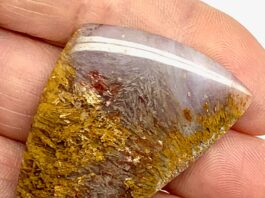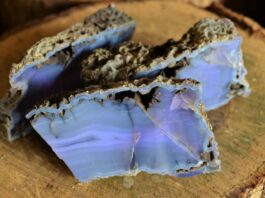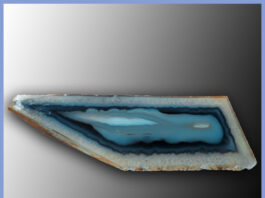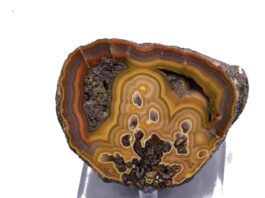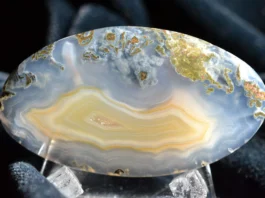Jacinth, also known as zircon, is a valuable and visually striking mineral that holds significance in both the world of gemology and geology. It is often used as a gemstone and is prized for its vibrant colors and high refractive index, but it also has a rich historical and cultural significance.


Definition and Basic Information:
Jacinth, commonly known as zircon, is a mineral species belonging to the nesosilicate group. Its chemical formula is ZrSiO4, indicating its composition of zirconium, silicon, and oxygen.
Zircon is a durable and dense mineral, ranking 6.5 to 7.5 on the Mohs scale of mineral hardness, making it suitable for use in jewelry and ornamental objects.
It is typically found in a variety of colors, including colorless, brown, red, yellow, green, and blue. Blue zircon, in particular, is highly sought after for its vivid and attractive hue.
Zircon often forms as small tetragonal prismatic crystals and can be transparent or translucent.
Historical Significance:
Zircon has a long history of use in various cultures. It is considered one of the oldest minerals on Earth, with some zircon crystals dating back more than 4.4 billion years. These ancient zircons are valuable to scientists for dating the Earth’s geological history.
In the Middle Ages, jacinth (a historical name for zircon) was believed to possess protective and healing properties. It was used as a talisman to ward off evil spirits, enhance the intellect, and promote wisdom.
During the Victorian era, zircon became popular in jewelry due to its brilliant sparkle and fire. It was often used as a diamond substitute in antique pieces.
In Hindu and Buddhist cultures, zircon has been used as a sacred stone in various rituals and religious artifacts, with a belief that it can bring wisdom, prosperity, and success.
Zircon has also been used in scientific research to determine the age of the Earth’s crust. The isotopic dating of zircon crystals has provided crucial insights into the geological history of our planet.
In summary, jacinth (zircon) is a versatile mineral with a rich historical background and a significant role in both the world of gemology and geology. Its aesthetic appeal and scientific importance continue to make it a valuable and sought-after mineral today.
Contents
Properties of Jacinth

Jacinth is another name for the gemstone known as zircon. Zircon is a mineral that is commonly used as a gemstone in jewelry. Here are some of its properties:
Physical Properties:
- Hardness: Zircon has a hardness of 6 to 7.5 on the Mohs scale, making it relatively durable and suitable for use in jewelry.
- Density: Zircon has a relatively high density, with a specific gravity ranging from 4.6 to 4.7.
- Cleavage: Zircon has no distinct cleavage, which means it doesn’t break along specific planes like some other minerals.
- Luster: Zircon typically exhibits a high luster, which can vary from adamantine to vitreous.
- Transparency: Zircon can be transparent, translucent, or opaque, depending on its impurities and clarity.
Chemical Properties:
- Chemical Composition: Zircon is a zirconium silicate mineral with the chemical formula ZrSiO4.
- Color: The natural color of zircon can vary widely, but it is commonly brown, yellow, red, green, or blue. Colorless zircon is also valued and is often used as a diamond substitute.
- Impurities: Various trace elements can influence the color of zircon. For example, uranium and thorium impurities can cause zircon to undergo radiation-induced changes in color over time.
Varieties and Colors:
- Hyacinth or Jacinth: This term is often used to describe the orange-red to brownish-red variety of zircon. It’s a historical name for a specific color range of zircon.
- Blue Zircon: Blue zircon is highly prized and comes in a range of blue shades, from light to deep blue. It is one of the most popular zircon colors for gemstone jewelry.
- Green Zircon: Green zircon can range from pale green to vivid green. Some green zircons may be heat-treated to enhance their color.
- Yellow and Golden Zircon: Zircon in shades of yellow and golden colors is relatively common and is used in jewelry.
- Colorless Zircon: Colorless zircon is often used as a diamond substitute and is valued for its brilliance and dispersion.
- Refractive Index: Zircon has a relatively high refractive index, typically around 1.810 to 2.024, which contributes to its brilliance and fire.
- Dispersion: Zircon has a high dispersion, which means it can separate light into its spectral colors, creating flashes of color (fire) when cut properly.
- Birefringence: Zircon is typically birefringent, meaning it can split a light ray into two rays with different velocities as it passes through the crystal.
- Double Refraction: Due to its birefringence, zircon can display double refraction, where an object viewed through the crystal appears doubled.
Zircon is a fascinating gemstone with a long history, and its properties make it a valuable addition to the world of gemology and jewelry.
Occurrence and Mining

Global Sources and Deposits: Zircon is found in a variety of geological settings and is distributed across the world. Some of the notable sources and deposits of zircon include:
- Australia: Australia is one of the largest producers of zircon. The Murray Basin in Victoria is particularly known for its zircon deposits.
- South Africa: South Africa has significant zircon deposits, primarily in the coastal regions.
- Mozambique: The coastal regions of Mozambique are also known for their zircon deposits, and they are often associated with other heavy minerals.
- USA: Florida and Georgia in the United States have zircon deposits, often found in association with ilmenite and rutile.
- Brazil: Zircon is found in the coastal areas of Brazil, primarily in the state of Bahia.
- Sri Lanka: Zircon is found in gem gravels in Sri Lanka, where it is often mined for use in jewelry.
- Cambodia: Zircon deposits can be found in the river sands of Cambodia, particularly along the Mekong River.
Extraction Methods: Zircon is typically extracted from its host material through a combination of mining and processing techniques:
- Dredging and Mining: In coastal regions, zircon-bearing sands are often extracted through dredging and mining operations. Heavy mineral sands that contain zircon are collected from beaches, dunes, and nearshore areas.
- Mineral Separation: After extraction, the collected sands are subjected to mineral separation processes. These processes use techniques such as gravity separation, magnetic separation, and flotation to separate zircon and other valuable minerals from the less dense materials.
- Chemical Treatment: In some cases, chemical treatments may be used to further purify zircon concentrates.
- Dry Mining: In some inland areas, zircon deposits may be mined using dry mining techniques, which involve digging into terrestrial deposits and using machinery to separate zircon from other minerals.
Mining and Environmental Considerations:
Mining zircon, like mining other minerals, has environmental considerations that need to be addressed to minimize the impact on ecosystems and local communities:
- Habitat Disruption: Coastal mining for zircon can disrupt coastal ecosystems, affecting local flora and fauna. It’s essential to carefully plan and manage mining operations to minimize habitat disruption.
- Water Management: Coastal mining can involve the use of water for processing and dredging. Managing water resources and avoiding contamination is crucial to prevent negative environmental impacts.
- Waste Management: Proper waste management is necessary to deal with tailings and waste products generated during the extraction and processing of zircon-bearing sands.
- Rehabilitation: Responsible mining companies often engage in habitat rehabilitation and reclamation efforts to restore the land to its natural state after mining operations are complete.
- Community Engagement: Engaging with local communities and obtaining their input and consent is essential in areas where zircon mining occurs. This helps address social and environmental concerns.
- Regulatory Compliance: Zircon mining operations must adhere to local, national, and international environmental and mining regulations to ensure responsible and sustainable practices.
- Health and Safety: Ensuring the health and safety of workers in the mining industry is a critical aspect of responsible mining.
Sustainable mining practices, environmental impact assessments, and adherence to regulations are essential to mitigate the environmental impact of zircon mining and ensure the long-term sustainability of the industry.
History and Cultural Significance

Zircon, often referred to as “jacinth” or “hyacinth” in historical contexts, has a rich history and cultural significance. Here are some key points regarding its historical and cultural importance:
Ancient History:
- Zircon has been used as a gemstone for over 2000 years. The term “hyacinth” was originally associated with a wide range of gemstones, but it later came to be linked primarily with red and brownish-red zircon.
- In ancient times, zircon was often confused with other gemstones due to its varying colors and properties. It was also frequently mistaken for other red gemstones like spinel and ruby.
- Zircon has been found in ancient jewelry, including amulets, rings, and pendants, and was used for decorative purposes.
Medieval and Renaissance Period:
- During the medieval and Renaissance periods, zircon was considered a popular gemstone and was used extensively in jewelry, including rings, necklaces, and brooches.
- Zircon was believed to have various mystical and healing properties. It was thought to enhance wisdom, intelligence, and positive thinking.
- The name “hyacinth” was derived from the Greek word “hyakinthos,” referring to a type of flower and, by extension, the gemstone’s color resemblance to the flower.
Religious and Cultural Significance:
- In some cultures, zircon has been associated with various religious and spiritual beliefs. It was believed to have protective and talismanic properties.
- In Hindu astrology, zircon is linked to the planet Venus and is worn to enhance marital bliss and financial prosperity.
- In Islam, zircon is sometimes used as a substitute for more expensive gemstones, as it is believed to be permissible to wear in jewelry.

Modern Usage:
- Zircon remains a popular gemstone for use in contemporary jewelry, particularly as an affordable and beautiful alternative to diamonds.
- Its wide range of colors, from blue and green to colorless and red, makes it versatile and appealing for use in a variety of jewelry designs.
- Modern lapidaries have developed cutting and faceting techniques to maximize zircon’s brilliance and fire, making it a sought-after gemstone for jewelry enthusiasts.
Gemological Significance:
- Zircon has been an essential gemstone in the field of gemology and mineralogy due to its varying colors, high refractive index, and dispersion.
- Its optical properties, such as its brilliance and fire, have made it a subject of scientific study and fascination for gemologists and jewelers.
- Gemological laboratories play a significant role in identifying and characterizing zircon and ensuring its authenticity in the gem market.
In summary, zircon, historically known as “hyacinth” or “jacinth,” has a long history of use in jewelry and has been valued for its beauty and cultural significance. It has played various roles in different cultures and has been appreciated for its distinctive colors and gemological properties. Today, zircon continues to be a popular gemstone for its versatility, affordability, and aesthetic appeal.
Jacinth (Zircon) in Jewelry

Jacinth, which is another name for the gemstone zircon, has been used in jewelry for centuries. Here’s a look at its use in jewelry, its various forms, and the popular styles and settings in which it is incorporated:
1. Gemstone Variety:
- Color Range: Zircon comes in a wide range of colors, including blue, green, yellow, red, brown, and colorless. Each color variation offers different aesthetic options for jewelry.
2. Types of Jewelry:
- Rings: Zircon is commonly used in rings, both as center stones and accent stones. It is often used as an alternative to more expensive gemstones like diamonds or sapphires.
- Earrings: Zircon can be set in earrings, either as studs, drops, or dangles. Colorless or blue zircon is particularly popular for earring designs.
- Necklaces and Pendants: Zircon pendants are a beautiful choice, especially when paired with complementary gemstones or metals. They can be worn close to the heart and come in various designs.
- Bracelets: Zircon can be used in bracelets, often as accent stones along with other gemstones, to add color and sparkle.
- Brooches and Pins: Zircon can be used as the focal point of brooches, adding a touch of elegance and color to outfits.
3. Styles and Settings:
- Solitaire Settings: Zircon can be set as a single, standalone gemstone in various types of jewelry, especially rings. A colorless zircon can resemble a diamond when set in a solitaire ring.
- Halo Settings: Zircon is often surrounded by a halo of smaller diamonds or other gemstones, enhancing its overall appearance and making it look more substantial.
- Vintage and Antique Styles: Zircon’s historical significance and the range of colors it offers make it suitable for vintage and antique jewelry styles, including Art Deco and Victorian designs.
- Modern and Contemporary Designs: Zircon is also featured in modern and contemporary jewelry, often in innovative and creative settings that highlight its unique colors.
- Birthstone Jewelry: Zircon is one of the birthstones for December, and it is often used in birthstone jewelry for those born in that month.
4. Durability and Care:
- Zircon’s hardness (6 to 7.5 on the Mohs scale) makes it suitable for everyday wear in most types of jewelry. However, care should be taken to avoid hard impacts that could cause chipping or damage.
- Cleaning zircon jewelry is typically done with warm soapy water and a soft brush. Avoid exposure to harsh chemicals, heat, and rapid temperature changes, as these can affect the gem’s appearance and durability.
5. Customization and Personalization:
- Many jewelers offer custom jewelry designs, allowing individuals to select their preferred zircon color, shape, and setting to create unique and personalized pieces.
Zircon’s affordability, brilliant luster, and availability in a spectrum of colors make it a versatile and attractive choice for jewelry. Whether used as the primary gemstone or in combination with other stones, zircon can add elegance, style, and individuality to various types of jewelry.
Gemstone Treatments

Gemstone treatments are various processes or enhancements applied to gemstones to improve their appearance or durability. These treatments are commonly used in the gemstone industry to make gemstones more attractive and marketable. It’s essential for consumers to be aware of any treatments a gemstone may have undergone, as it can affect its value and care requirements. Here are some common gemstone treatments:
- Heat Treatment:
- Purpose: Heat treatment is used to enhance the color and clarity of certain gemstones. It can remove or reduce undesirable inclusions and improve color saturation.
- Gemstones Affected: Heat treatment is commonly applied to sapphires, rubies, and tanzanite.
- Disclosure: Heat-treated gemstones should be disclosed as such when sold.
- Irradiation:
- Purpose: Irradiation can change or enhance the color of some gemstones. It’s often followed by a heat treatment to stabilize the color change.
- Gemstones Affected: Blue topaz, some green diamonds, and some pearls may be irradiated.
- Disclosure: Irradiation treatment should be disclosed.
- Lattice Diffusion:
- Purpose: Lattice diffusion is used to introduce elements into a gemstone’s lattice structure, creating color zones or patterns.
- Gemstones Affected: It is commonly applied to sapphires to create or enhance the appearance of a star or a padparadscha effect.
- Disclosure: Lattice diffusion should be disclosed.
- Oil Treatment:
- Purpose: Oil treatment is used to fill surface-reaching fractures or cavities in certain gemstones to improve clarity.
- Gemstones Affected: Emeralds are often oiled to improve their appearance.
- Disclosure: Oiling is typically disclosed in the gemstone’s description.
- Resin or Polymer Impregnation:
- Purpose: This treatment is used to fill fractures and cavities in gemstones to improve durability and appearance.
- Gemstones Affected: It is commonly applied to porous gemstones like turquoise.
- Disclosure: Impregnation treatments should be disclosed.
- Surface Coating:
- Purpose: A thin layer of a substance is applied to the surface of a gemstone to alter or enhance its color or optical properties.
- Gemstones Affected: Some diamonds and lower-quality pearls may be surface-coated.
- Disclosure: Surface coatings should always be disclosed.
- Beryllium Treatment:
- Purpose: Beryllium treatment is used to enhance the color of certain sapphires by introducing beryllium into their lattice structure.
- Gemstones Affected: Sapphires, particularly those with orange or pink hues.
- Disclosure: Beryllium treatment should be disclosed.
- High-Pressure, High-Temperature (HPHT):
- Purpose: HPHT treatment can alter the color and clarity of certain diamonds, making them more valuable.
- Gemstones Affected: Mostly diamonds.
- Disclosure: HPHT-treated diamonds should be disclosed as such.
It’s crucial for buyers to request and receive full disclosure about any gemstone treatments when purchasing jewelry. The treatments can significantly affect the gemstone’s value, care requirements, and long-term durability. Additionally, reputable jewelers and gem dealers should provide information about any treatments and their impact on the gem’s quality.
Scientific and Industrial Applications

Zircon, the mineral that is also known as “jacinth,” has a range of scientific and industrial applications due to its unique properties. Some of these applications include:
1. Geochronology:
- Zircon is often used in geology and earth sciences for radiometric dating. Zircon crystals can contain trace amounts of uranium, which slowly decays into lead. By measuring the ratio of uranium to lead isotopes in zircon, scientists can determine the age of rocks and minerals with remarkable accuracy. This is especially useful for dating the Earth’s crust and understanding geological history.
2. Nuclear Industry:
- Zirconium, derived from zircon, is used in the nuclear industry to make fuel rods and cladding for nuclear reactors. Zirconium’s low neutron-absorption properties and corrosion resistance make it an ideal material for this purpose.
3. Ceramic and Refractory Materials:
- Zircon is used as a key ingredient in the production of high-temperature and wear-resistant ceramics and refractory materials. Zirconia (zirconium dioxide) is particularly valuable in this regard, as it can withstand extreme heat and chemical corrosion.
4. Metallurgy:
- Zirconium alloys are used in the metallurgical industry to make equipment and components that must withstand high temperatures and corrosive environments, such as the linings of furnaces and crucibles.
5. Glass Manufacturing:
- Zircon is used as a raw material in the production of high-quality glass, including optical glass and glass ceramics. It improves the clarity, durability, and refractive properties of glass.
6. Foundry Sand:
- Zircon sand is used as a foundry material in the casting of metal products. It provides a refractory lining for molds and cores, helping to withstand the extreme temperatures and mechanical stresses of the casting process.
7. Grinding and Polishing:
- Zirconia-based materials are used in grinding and polishing applications, particularly for metalworking and surface finishing. They offer high abrasion resistance and long-lasting performance.
8. Electrical Insulators:
- Zircon is used to produce electrical insulators, as it has excellent dielectric properties and can withstand high voltage and high-temperature conditions.
9. Catalysts:
- Zirconium compounds, derived from zircon, are used as catalysts in various chemical reactions and industrial processes, including the petroleum and chemical industries.
10. Zirconium Oxide Coatings:
- Zirconium oxide coatings can be applied to certain materials to improve their resistance to wear, corrosion, and high temperatures. This is valuable in industries such as aerospace and electronics.
11. Gemology and Jewelry:
- Zircon is also highly valued as a gemstone used in jewelry, known for its brilliance, fire, and a wide range of colors.
Zircon, with its combination of physical and chemical properties, makes it a versatile material with a broad range of scientific and industrial applications. Its importance extends beyond its use as a gemstone to contribute to various technological advancements and the functionality of different industrial processes.
Caring for Jacinth (Zircon)

Caring for jacinth, which is another name for the gemstone zircon, is essential to maintain its appearance and durability. While zircon is relatively hard (6 to 7.5 on the Mohs scale), it still requires proper care to avoid damage and keep it looking its best. Here are some tips for caring for jacinth (zircon) jewelry:
- Avoid Abrasive Contact:
- Zircon can scratch other materials, so it’s essential to store your jacinth jewelry separately from other jewelry to prevent scratches. Also, avoid wearing it when engaging in activities that may expose it to abrasive surfaces.
- Cleaning:
- Clean your jacinth jewelry regularly to remove dirt, oils, and debris that can dull its luster. Use a soft brush or cloth to gently scrub the surface, and you can use warm, soapy water for more thorough cleaning. Avoid abrasive cleaners or ultrasonic cleaners, as they can damage the stone or any treatments it may have undergone.
- Chemical Exposure:
- Avoid exposing your jacinth jewelry to harsh chemicals, such as bleach, chlorine, or other household cleaning agents. These chemicals can damage or discolor the stone.
- Heat and Light:
- Extended exposure to high heat or direct sunlight can cause the color of some zircons to fade. Store your jacinth jewelry in a cool, dry place, and avoid leaving it in direct sunlight for extended periods.
- Protect from Impact:
- Zircon can chip or break if subjected to strong impacts, so it’s best to remove your jacinth jewelry when engaging in activities where it may be hit or bumped, such as sports or heavy physical labor.
- Storing Properly:
- When not wearing your jacinth jewelry, store it in a jewelry box or a soft pouch to protect it from dust and potential scratches. To prevent tangling, store necklaces and pendants individually, and use compartmentalized jewelry boxes.
- Check for Loose Settings:
- Regularly inspect the settings of your jacinth jewelry to ensure that the gemstone is secure. If you notice any loose prongs or settings, have them repaired promptly to prevent the stone from becoming dislodged.
- Professional Cleaning:
- Periodically, consider taking your jacinth jewelry to a professional jeweler for a thorough cleaning and inspection. They can check for any potential issues and clean your jewelry using specialized equipment and methods.
- Avoid Sudden Temperature Changes:
- Zircon is sensitive to sudden temperature changes. Avoid exposing your jacinth jewelry to extreme hot and cold temperature variations, as this can lead to stress and potentially cause the stone to crack.
By following these care tips, you can help ensure that your jacinth (zircon) jewelry remains in excellent condition and retains its beauty for many years to come.
Famous Jacinth (Zircon) Gemstones

While zircon (sometimes referred to as “jacinth”) is not as famous as some other gemstones like diamonds or sapphires, it has been used in various pieces of jewelry, and a few notable jacinth gemstones have gained recognition for their beauty and historical significance. Here are a few famous jacinth (zircon) gemstones:
- The Star of Sri Lanka:
- The Star of Sri Lanka, also known as the Lanka Star, is a famous jacinth gemstone. This blue zircon exhibits a six-rayed star on its surface when cut in a cabochon shape. The star effect is caused by the alignment of needle-like inclusions within the stone, creating a stunning asterism. It has a long history of ownership, and at one point, it belonged to the British royal family.
- The Jarkan or Hyacinth Gem in the Imperial Scepter of the Russian Crown Jewels:
- The Imperial Scepter of the Russian Crown Jewels contains a jacinth (zircon) gemstone known as the “jarkan” or “hyacinth.” This is a large red zircon that is part of the Orlov Diamond, a famous historic diamond. The gem is set in the top of the scepter and is a significant component of this iconic Russian imperial regalia.
- The Star of Cambodia:
- The Star of Cambodia is a large blue jacinth (zircon) with a noticeable asterism, displaying a star-like pattern when exposed to light. This gem is associated with Cambodia and has garnered attention for its unique optical effect.
- The Golden Star of David:
- The Golden Star of David is a large golden jacinth (zircon) that exhibits a prominent six-pointed star pattern. It is highly prized for its rich color and remarkable star effect. This gemstone is a prominent example of a golden zircon with a stunning asterism.
While these jacinth (zircon) gemstones may not be as famous as some other gemstones, they hold historical and cultural significance and are admired for their unique optical properties and beauty.
Myths, Legends, and Folklore

Jacinth, also known as zircon, has been associated with various myths, legends, and folklore throughout history, often due to its striking appearance and perceived mystical properties. Here are some examples of how jacinth has been woven into cultural narratives:
- Healing and Protective Properties:
- In some ancient cultures, jacinth was believed to possess healing properties. It was thought to cure ailments and protect against illness, making it a popular choice for amulets and talismans.
- Mythological Significance:
- In certain mythologies, jacinth was associated with mythical creatures and beings. For example, in ancient Greece, jacinth was sometimes linked to the mythological figure Hyacinthus, a handsome youth loved by the god Apollo. According to the myth, the blood of Hyacinthus was transformed into the hyacinth flower, which was named in his honor. Although the hyacinth flower is different from the gemstone jacinth, the association between the two has persisted in cultural references.
- Magical and Mystical Beliefs:
- Throughout history, jacinth has been attributed with mystical and magical qualities. It was thought to protect against evil spirits and enhance psychic abilities. Some believed that wearing jacinth jewelry could bring good luck and ward off negative energies.
- Historical and Biblical References:
- The term “jacinth” has historical and biblical significance. In the Book of Revelation in the Bible, the word “jacinth” is used in the description of the foundations of the New Jerusalem. The jacinth here is likely referring to a blue or deep indigo gem, but its use in a biblical context has added to its cultural and religious symbolism.
- Folklore and Superstitions:
- In various cultures, jacinth has been linked to folklore and superstitions. For instance, some believed that wearing jacinth jewelry would bring happiness and protect against negative energies. In some regions, jacinth was used to create amulets believed to have supernatural powers.
- Lunar and Astral Connections:
- In astrology and mysticism, jacinth is sometimes associated with the moon, the stars, and astral travel. It is thought to enhance one’s intuition and connection with the celestial realm.
- Cultural and Symbolic Meanings:
- In different cultures, jacinth may hold symbolic meanings associated with specific colors. For example, blue jacinth may be linked to themes of calmness, serenity, and communication, while red or orange jacinth may be associated with themes of passion and energy.
While these beliefs and associations may not be scientifically validated, they contribute to the cultural and historical significance of jacinth (zircon). It has been revered and used in various ways for its perceived mystical properties and beauty.
Conclusion

Summary of Key Points about Jacinth (Zircon):
Jacinth, also known as zircon, is a gemstone with a rich history and diverse properties. Here are the key points to remember about this gemstone:
- Physical Properties: Zircon is a durable gemstone with a hardness of 6 to 7.5 on the Mohs scale. It exhibits a high refractive index and dispersion, which gives it exceptional brilliance and fire.
- Varieties and Colors: Zircon comes in a wide range of colors, including blue, green, yellow, red, brown, and colorless. The availability of various colors makes it suitable for different types of jewelry.
- Historical and Cultural Significance: Jacinth (zircon) has been used in jewelry for centuries and has been associated with various myths, legends, and cultural beliefs. It has a historical connection to healing, protection, and mystical properties.
- Scientific and Industrial Applications: Zircon, derived from jacinth, has scientific and industrial applications, such as geochronology for dating rocks, use in the nuclear industry, production of ceramics, and more.
- Gemological Significance: Zircon is valued in the field of gemology for its unique optical properties and is a subject of scientific study.
- Caring for Jacinth: To maintain the beauty and durability of jacinth (zircon) jewelry, it’s essential to take precautions, such as avoiding abrasive contact, cleaning it regularly, and protecting it from chemicals and extreme temperatures.
- Famous Jacinth Gemstones: While not as famous as some other gemstones, jacinth (zircon) has been used in notable gemstones, such as the Star of Sri Lanka and the Imperial Scepter of the Russian Crown Jewels.
- Myths, Legends, and Folklore: Jacinth has been associated with healing, protection, mythical figures, and mystical beliefs in various cultures and traditions.
Future Outlook for the Gemstone:
The future outlook for jacinth (zircon) remains positive, with continued demand in the jewelry market and ongoing scientific and industrial applications. Some factors contributing to its future outlook include:
- Variety of Colors: The broad range of colors in which zircon is available offers flexibility and diversity for jewelry designers, making it a versatile gemstone for creative jewelry designs.
- Sustainability and Ethical Sourcing: As the demand for ethically sourced gemstones grows, the gem industry is increasingly focusing on responsible mining and ethical practices, which could benefit the reputation of zircon.
- Gemological Research: Ongoing research into gemological properties and treatments of zircon may lead to enhanced understanding and appreciation of this gemstone, potentially boosting its popularity.
- Cultural and Historical Appeal: Jacinth’s historical and cultural significance adds to its enduring appeal, and it will continue to be appreciated for its unique place in the world of gemstones.
In conclusion, jacinth (zircon) is a gemstone with a fascinating history, a wide range of applications, and continued relevance in the world of jewelry and gemology. Its future outlook remains positive, driven by its versatility and cultural significance.


